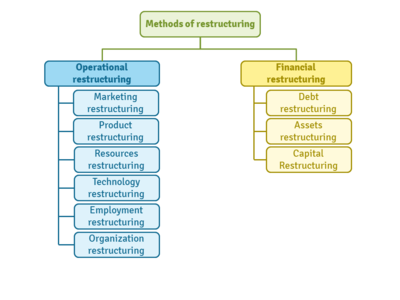Methods of restructuring: Difference between revisions
(Infobox update) |
|||
| Line 25: | Line 25: | ||
==Most common methods of restructuring== | ==Most common methods of restructuring== | ||
[[File:methods_of_restructuring.png|400px|right|thumb|Fig.1. Methods of restructuring]] | |||
1. '''Operational restructuring''' - includes changes in the core business operations. [[Profit]] or operating loss is reflected in changes in the level and structure of business assets: | 1. '''Operational restructuring''' - includes changes in the core business operations. [[Profit]] or operating loss is reflected in changes in the level and structure of business assets: | ||
* [[Marketing]] restructuring - involves changes leading to increased sales, strengthening position in the [[market]] by keeping [[flexible pricing]] policy, etc. | * [[Marketing]] restructuring - involves changes leading to increased sales, strengthening position in the [[market]] by keeping [[flexible pricing]] policy, etc. | ||
Revision as of 06:50, 8 September 2020
| Methods of restructuring |
|---|
| See also |
Restructuring means major changes made in the enterprise which goal is to improve organizational structure and operating effectiveness.
There can be distinguished following types of restructuring:
- Restructuring of equity - applies to legal and economic transformations,
- Operational restructuring - applies to changes in the technology and product assortment,
- Repairing restructuring - applies to businesses facing liquidation, mostly due to the bad situation of the company. Aims to improve the unfavourable economic conditions and the restoration of solvency.
- Development restructuring - based on strategic decisions taken by the management, concerns the activities of an innovative development. It covers the period from 2 to 5 years.
Most common methods of restructuring
1. Operational restructuring - includes changes in the core business operations. Profit or operating loss is reflected in changes in the level and structure of business assets:
- Marketing restructuring - involves changes leading to increased sales, strengthening position in the market by keeping flexible pricing policy, etc.
- Product restructuring - includes changes to the existing range of products,
- Restructuring of the company's resources - is aimed to increase the efficiency of real property and human resources to meet the success criteria prevailing in the market,
- Technological restructuring - merge changes to the product offer of the company and means to manufacture this products,
- Restructuring of employment - changes in the employment structure leading to lower costs and it's adaptation to the needs of the enterprise,
- Organisational restructuring and changes in enterprise management system - involves customizing of the internal structure of the company to comply with the implementation of the strategies adopted.
2. Financial restructuring - includes activities in the financial management systems leading to greater financial gains or in case of loss of liquidity to restore the company solvency:
- Restructuring of the debt (debt reduction) - the pursuit of a settlement between the creditor and debtor,
- Restructuring of assets - through the sale, lease, and through strategic alliances or continuous transfer of resources between partners,
- Restructuring of capital - increases the efficiency of invested capital.
Restructuring as a tool for organizational improvement
Development of the company through restructuring involves improvement in existing structures and systems. It has two varieties:
- restructuring as fixing problems,
- dynamic restructuring.
Restructuring as problem fixing tends to restore the original state of the company. In Polish conditions, a special case of this variety is restructuring of procedures to achieve a state of solvency.
Dynamic restructuring is aimed at diversification and modernization of the company. In this case main goal is to improve the organization and operation of such an extent that it reaches the economic performance compared to the original state. The dynamic restructuring involves looking for ways of development of such companies, which would lead to a higher results than satisfactory or good. This applies for example to improving the organizational structure, strengthening the economic and financial situation, improving product quality, expanding the profile of production and portfolio.
Other means than the development by restructuring is development by innovation. This includes creating new, original and effective theoretical concepts and specific practical solutions in various fields of activity. The results of the development through innovation are the designs that express a new level of quality. This new quality is determined by the discovery of the characteristic properties of the tested system and an indication of its strengths. It may also relate to the used management concept and research methods.
See also:
References
- Best, M. H. (1990). The new competition: institutions of industrial restructuring. Harvard University Press.
- Djankov, S., & Murrell, P. (2002). Enterprise restructuring in transition: A quantitative survey. Journal of economic literature, 40(3), 739-792.
- Mitchell, M. L., & Mulherin, J. H. (1996). The impact of industry shocks on takeover and restructuring activity. Journal of financial economics, 41(2), 193-229.
- Osterman, P. (2000). Work reorganization in an era of restructuring: Trends in diffusion and effects on employee welfare. Industrial & Labor Relations Review, 53(2), 179-196.
